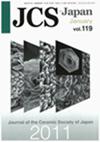High-mobility rutile SnO<sub>2</sub> epitaxial films grown on (1−100) α-Al<sub>2</sub>O<sub>3</sub>
IF 1.1
4区 材料科学
Q3 MATERIALS SCIENCE, CERAMICS
引用次数: 0
Abstract
Tin dioxide (SnO2) is a semiconductor with significant potential for use in the electronic industry, including sensors, transparent electrodes, and thin film transistors among other purposes. To realize these applications, the synthesis of high-quality thin films is a prerequisite. Here, we show the epitaxial growth of SnO2 films on (1100) α-Al2O3 (M-sapphire) by pulsed laser deposition method. The epitaxial relationship was clarified to be (001)[100]SnO2 || (1100)[0001] α-Al2O3 with 4-fold symmetry, consistent with that grown on (001) TiO2 single crystal. Orthorhombic distortion was absent, possibly owing to a combination of high strain relaxation due to a large lattice mismatch along [0001] α-Al2O3, coupled with a negligible mismatch-induced strain absence along [1120] α-Al2O3. The mobility increases up to ∼57 cm2 V−1 s−1 with increasing film thickness while the density of states (DOS) effective mass keeps a constant around the theoretical value of ∼0.3 m0. Furthermore, the trend of carrier concentration versus mobility is analogous to those of single crystal SnO2, thereby indicating the applicability of M-sapphire substrates in facilitating the epitaxial growth of high-quality SnO2 films.高迁移率金红石SnO<sub>2</sub>(1−100)α-Al<sub>2</sub>O<sub>3<
二氧化锡(SnO2)是一种半导体,在电子工业中具有重要的应用潜力,包括传感器、透明电极和薄膜晶体管等用途。要实现这些应用,高质量薄膜的合成是前提条件。本文采用脉冲激光沉积法在(1100)α-Al2O3 (m -蓝宝石)表面外延生长SnO2薄膜。外延关系为(001)[100]SnO2 || (1100)[0001] α-Al2O3,具有4重对称,与生长在(001)TiO2单晶上的外延关系一致。正交畸变不存在,这可能是由于沿[0001]α-Al2O3的大晶格失配引起的高应变松弛,以及沿[1120]α-Al2O3的可忽略不计的失配引起的应变缺失的结合。随着膜厚度的增加,迁移率增加到~ 57 cm2 V−1 s−1,而态密度(DOS)有效质量保持在理论值~ 0.3 m0附近恒定。此外,载流子浓度随迁移率的变化趋势与单晶SnO2相似,从而表明m -蓝宝石衬底在促进高质量SnO2薄膜外延生长方面的适用性。
本文章由计算机程序翻译,如有差异,请以英文原文为准。
求助全文
约1分钟内获得全文
求助全文
来源期刊

Journal of the Ceramic Society of Japan
工程技术-材料科学:硅酸盐
CiteScore
2.10
自引率
18.20%
发文量
170
审稿时长
2 months
期刊介绍:
The Journal of the Ceramic Society of Japan (JCS-Japan) publishes original experimental and theoretical researches and reviews on ceramic science, ceramic materials, and related fields, including composites and hybrids. JCS-Japan welcomes manuscripts on both fundamental and applied researches.
 求助内容:
求助内容: 应助结果提醒方式:
应助结果提醒方式:


